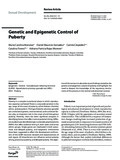| dc.rights.licence | Atribución-NoComercial 4.0 Internacional | * |
| dc.contributor.author | Manotas, Maria | |
| dc.contributor.author | González Cubides, Daniel Mauricio | |
| dc.contributor.author | Cespedes Salazar, Camila | |
| dc.contributor.author | Forero Ronderos, Catalina | |
| dc.contributor.author | Rojas, Adriana | |
| dc.date.accessioned | 2022-05-31T17:18:25Z | |
| dc.date.available | 2022-05-31T17:18:25Z | |
| dc.date.created | 2021-10-14 | |
| dc.identifier | https://www.karger.com/Article/FullText/519039 | spa |
| dc.identifier.issn | 1661-5425 / 1661-5433 (Electrónico) | spa |
| dc.identifier.uri | http://hdl.handle.net/10554/60075 | |
| dc.description.abstract | Puberty is a complex transitional phase in which reproductive capacity is achieved. There is a very wide variation in the age range of the onset of puberty, which follows a familial, ethnic, and sex pattern. The hypothalamic-pituitary-gonadal axis and several genetic, environmental, and nutritional factors play an important role in the onset of and throughout puberty. Recently, there has been significant progress in identifying factors that affect normal pubertal timing. Different studies have identified single nucleotide polymorphisms (SNPs) that affect pubertal timing in both sexes and across ethnic groups. Single genes are implicated in both precocious and delayed puberty, and epigenetic mechanisms have been suggested to affect the development and function of the GnRH neuronal network and responsiveness of end organs. All these factors can influence normal puberty timing, precocious puberty, and delayed puberty. The objective of this review is to describe recent findings related to the genetic and epigenetic control of puberty and highlight the need to deepen the knowledge of the regulatory mechanisms of this process in the normal and abnormal context. | spa |
| dc.format | PDF | spa |
| dc.format.mimetype | application/pdf | spa |
| dc.rights.uri | http://creativecommons.org/licenses/by-nc/4.0/ | * |
| dc.subject | Epigenetic | spa |
| dc.subject | Genetic | spa |
| dc.subject | Gonadotropin-Releasing Hormone (Gnrh) | spa |
| dc.subject | Hypothalamic-Pituitary-Gonadal Axis (Hpg) | spa |
| dc.subject | Kiss1 | spa |
| dc.subject | Puberty | spa |
| dc.title | Genetic and epigenetic control of puberty | |
| dc.type.hasversion | http://purl.org/coar/version/c_ab4af688f83e57aa | |
| dc.description.quartilewos | Q4 | spa |
| dc.description.quartilescopus | Q3 | |
| dc.identifier.doi | https://doi.org/10.1159/000519039 | spa |
| dc.type.local | Artículo de revista | spa |
| dc.contributor.corporatename | Pontificia Universidad Javeriana. Facultad de Medicina. Instituto de Genética Humana. Grupo de investigación Instituto de Genética Humana | |
| dc.contributor.corporatename | Pontificia Universidad Javeriana. Facultad de Medicina. Hospital Universitario San Ignacio | spa |
| dc.contributor.corporatename | Pontificia Universidad Javeriana. Facultad de Medicina. Departamento de Pediatría | |
| dc.identifier.instname | instname:Pontificia Universidad Javeriana | spa |
| dc.identifier.reponame | reponame:Repositorio Institucional - Pontificia Universidad Javeriana | spa |
| dc.identifier.repourl | repourl:https://repository.javeriana.edu.co | spa |
| dc.type.coar | http://purl.org/coar/resource_type/c_dcae04bc | spa |
| dc.description.orcid | https://orcid.org/0000-0002-7856-7213 | |
| dc.description.orcid | https://orcid.org/0000-0003-2241-7854 | |
| dc.description.orcid | https://orcid.org/0000-0002-4900-4948 | |
| dc.description.orcid | https://orcid.org/0000-0001-8225-4394 | |
| dc.description.orcid | https://orcid.org/0000-0001-8528-4433 | |
| dc.relation.citationstartpage | 1 | spa |
| dc.relation.citationendpage | 10 | spa |
| dc.relation.ispartofjournal | Sexual Development | spa |
| dc.contributor.javerianateacher | Cespedes Salazar, Camila | |
| dc.contributor.javerianateacher | Rojas, Adriana | |
| dc.contributor.ascribedclinicalteacher | Forero Ronderos, Catalina | |
| dc.description.indexing | Revista Internacional - Indexada | spa |
| dc.relation.citationvolume | 16 | spa |
| dc.relation.citationissue | 1 | spa |
| dc.rights.coar | http://purl.org/coar/access_right/c_abf2 | spa |
| dc.description.publindex | B | spa |
| dc.description.esci | SI | spa |


